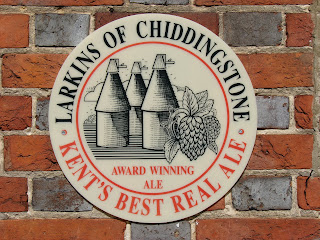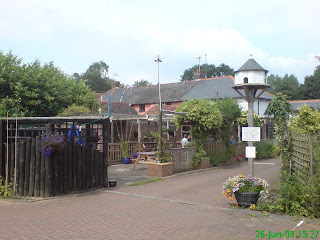




I managed to get away from work last Friday and enjoyed a glorious day's rambling in the Kent countryside. Four of us did the walk, travelling by bus to the village of Mereworth, and then climbing up through the woods that are named after the village. Despite having lived in this part of Kent for thirty odd years, this was the first time I had walked up through the woods which cover this section of the Greensand Ridge. What was particularly appealing was the number of isolated dwellings, set down narrow side roads seemingly miles from anywhere, that we came across. We were especially taken with the aptly named Keeper's Cottage, set in a clearing all on its own - like something out of a Brothers Grimm fairy tale.
Eventually we left the shelter of the trees passing through orchards instead. This small area of the county is the centre of the Kent Cobnut growing industry and it was good to see the trees already laden with small, immature nuts indicating a good harvest come September. Our destination was the Golding Hop, a wonderfully unspoilt pub, in an idyllic rural setting, which lies on the opposite side of the Bourne Valley. We reached our goal shortly before one o'clock, and entered keen to sample one or more of the gravity-drawn beers.
The choice that Friday included Adnams Bitter, Thwaites Nutty Slack Mild, Marstons Ashes, plus a beer from Springhead Brewery, who's name escapes me. For those not in the know, the Golding Hop is run by Eddie and his wife Sonia, and has been for the past twenty five years or so. The pub itself is built into the side of a hill, overlooking a narrow lane, and is over 300 years old. As mentioned earlier, the beers are served by gravity from casks stillaged in a room behind the bar. The Golding Hop is also famed for its cider, and as well as varieties like Westons the pub produces its own "rough cider", from a recipe that has been handed down over the years from one licensee to the next.
We sat outside on the small terrace in front of the pub, enjoying the late spring sunshine, but in winter the interior of the pub, with its low beamed ceilings and wood-burning stove is equally appealling. On the other side of the lane is an extensive garden, complete with swings and climbing frame for the kids, plus a large car-park; such is the popularity of the Golding Hop on summer weekends. A small, limited menu offers basic pub-grub of the chips and baked beans with everything variety. The food is good value though, as are the beers. The most expensive were the Adnams and the Marstons at £2.60 a pint; the Thwaites was the cheapest at just £2.20, with the Springhead somewhere in between. With these prices it is hard to believe towns like Sevenoaks are just a short distance away, whilst London itself can't be more than thirty miles distant!
We reluctantly said goodbye to the Golding Hop just after the 3pm closing time, and set off to walk into the nearby village of Plaxtol. On the way we passed some very attractive and expensive looking properties, and before entering the village were rewarded with some spectacular views across the Bourne Valley. Plaxtol itself is quite a large village but without an obvious centre. We passed the former Rorty Crankle pub, now sadly a private dwelling, before coming upon the Papermakers Arms.
We hadn't intended to stop for another pint at this stage, but the pub was open and looked very inviting. It is probably getting on for thirty years since I last had a pint in the Papermakers so a return visit was long overdue. Internally the pub has one large bar, divided into two distinct halves. The servery is to the right, whilst to the left is a carpeted area, complete with a red-beige pool table, plus some comfortable sofas. Leading off from here is the pub's dining area. Two cask ales were on offer, Harveys Best - dispensed from a cask behind the bar, plus Timothy Taylors Landlord. We opted for the latter, price £3.10 a pint, and in excellent condition.
We were the only customers in the pub that afternoon, but we had an interesting chat with the landlady, who told us she was planing to switch over to gravity dispense, using a system similar to that of the Halfway House at Brenchley. The food menu at the Papermakers looked good and reasonably priced, with fish cooked in beer batter their speciality. At the rear of the pub is an attractive and well-laid out garden area, with a" play cottage" for the kids. We were all impressed with the pub, and were glad we called in.
It was onwards, and in this case, downwards to our final destination, the
Swan on the Green at West Peckhham. First we had to get there though, so we descended down towards the valley of the River Bourne. which in reality is nothing more than a stream. We were joined on this section of the walk by a mother and her two boys, plus the family dog, who were making their way home from school. The mother confirmed we were on the right path, and we walked with them towards their family home. When we parted company, we all thought how refreshing (and unusual) in this day and age of molly-coddling children, to walk home with them, across the fields through some very attractive countryside, instead of turning up at the school gate to whisk them home in the family 4x4!
Climbing up the other side of the River Bourne, we made our way along the Greensand Way, which follows the line of the ridge of the same name. We passed fields of both strawberries and raspberries, the latter ripening under large poly-tunnels. This is a renowned soft fruit growing area, being ideally suited with warm south-facing slopes and easy draining soils. Eventually, just before 6 o'clock opening time, we reached the tiny village of West Peckham. This really is a settlement on the road to nowhere; a turning off the Mereworth-Plaxtol road leads into the village and stops abruptly at the attractive village green. The latter has a cricket pitch, and is overlooked by the small church plus, of course, the village pub.
The Swan in the Green is a brew-pub, and has been so since the start of the millennium. A range of 10 different beers are brewed in the small micro-brewery at the rear of the pub, including a mild, a porter and a lager, which complement the various bitters and pale ales that are the pub's mainstay. What's more, the beers are all realistically priced. Having consumed a fair amount of beer already that day, I sensibly stuck to the weakest beer on offer the Fuggles, which as its name suggests is a well-hoped session beer at 3.6%, costing a very reasonable £2.50 a pint. My companions tried a couple of the stronger bitters, which included Cygnet at 4.2% and Bewick at 5.3%. The latter was still good value at £2.90. I can thoroughly recommend the Swan; despite having an accent on food at one end of the pub, it still functions as a village local. Drinkers are every bit as welcome as diners, and the pub-brewed beers are well worth sampling.
We left the Swan whilst it was still light, and walked back along the road to Mereworth. Here we were just in time for the 8.40pm bus back to Tonbridge, although we nearly boarded a bus taking a group of weary fruit-pickers back to their accommodation by mistake. It had been a truly excellent day out, and one that had taken us through some magnificent countryside. The fact that such unspoilt rural vistas are virtually on our doorstep made us realise just how lucky we are living in this part of the country. That there are still some wonderfully unspoilt and thriving pubs around, selling good beer at reasonable prices makes me feel that well-run rural pubs still have a future. I could go on to contrast the prices we found on our walk with those encountered just a couple of days previously, and only a dozen or so miles away, but I appreciate I have waffled on long enough. Thank-you for your patience; I hope you have enjoyed my description of our walk through the Garden of England.
















